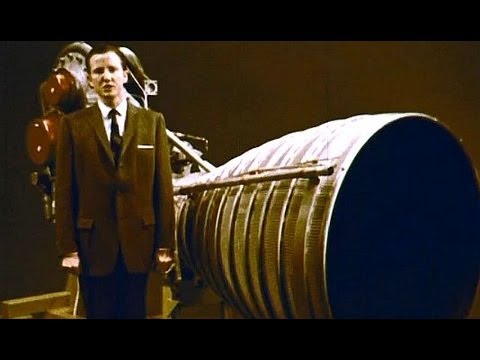more at
“The theory of reaction engines and the application to the Saturn propulsion system.” Includes film of the first Saturn I launch in 1961 (SA-1).
NASA f HQ-a77
I couldn’t do much to improve the color on this one, but the sound cleaned up nicely.
NEW VERSION with improved video & sound:
Reupload of a previously uploaded film with improved sound and video.
Public domain film from NASA, slightly cropped to remove uneven edges, with the aspect ratio corrected, and 1-pass exposure & color correction applied (cannot be ideal in all scenes).
The soundtrack was also processed with volume normalization, noise reduction, clipping reduction, and/or equalization (the resulting sound, though not perfect, is far less noisy than the original).
Rocket engine development history: V-2 engine led to Navaho engine led to Atlas engine led to Saturn H-1 engine.
…Development of the first stage rocket engine for the Navaho began with two refurbished V-2 engines in 1947. That same year, the phase II engine was designed, the XLR-41-NA-1, a simplified version of the V-2 engine made from American parts. The phase III engine, XLR-43-NA-1 (also called 75K), adopted a cylindrical combustion chamber with the experimental German impinging-stream injector plate. Engineers at North American were able to solve the combustion stability problem, which had prevented it being used in the V-2, and the engine was successfully tested at full power in 1951. The Phase IV engine, XLR-43-NA-3 (120K), replaced the poorly cooled heavy German engine wall with a brazed tubular (“spaghetti”) construction, which was becoming the new standard method for regenerative cooling in American engines. A dual-engine version of this, XLR-71-NA-1 (240K), was used in the G-26 Navaho. With improved cooling, a more powerful kerosene-burning version was developed for the triple-engine XLR-83-NA-1 (405K), used in the G-38 Navaho. With all the elements of a modern engine (except a bell-shaped nozzle), this led to designs for the Atlas, Thor and Titan engines…
Rocketdyne’s H-1 is a 205,000 lbf (910 kN) thrust liquid-propellant rocket engine burning LOX and RP-1. The H-1 was developed for use in the S-IB first stage of the Saturn I and Saturn IB rockets, where it was used in clusters of eight engines. After the Apollo program, surplus H-1 engines were rebranded and reworked as the Rocketdyne RS-27 engine with first usage on the Delta 2000 series in 1974…
The F-1 is a rocket engine developed by Rocketdyne and used in the Saturn V. Five F-1 engines were used in the S-IC first stage of each Saturn V, which served as the main launch vehicle in the Apollo program. The F-1 is still the most powerful single-chamber liquid-fueled rocket engine ever developed. The RD-170 has slightly more thrust, using a cluster of four smaller combustion chambers and nozzles…
The J-2 was a liquid-fuel cryogenic rocket engine used on NASA’s Saturn IB and Saturn V launch vehicles. Built in the United States of America by Rocketdyne, the J-2 burned cryogenic liquid hydrogen & liquid oxygen propellants, with each engine producing 1,033.1 kN (232,250 lbf) of thrust in vacuum. Development of the engine began in the 1960s, with the first flight, AS-201, occurring on 26 February 1966. The J-2 underwent several minor upgrades over its operational history to improve the engine’s performance, with two major upgrade programs, the de Laval nozzle-type J-2S and aerospike-type J-2T, being cancelled after the conclusion of the Apollo program.
Five J-2 engines were used on the Saturn V’s S-II second stage, and one J-2 was used on the S-IVB upper stage used on both the Saturn IB and Saturn V. Proposals also existed to use various numbers of J-2 engines in the upper stages of an even larger rocket, the planned Nova. The J-2 was America’s largest production liquid hydrogen fuelled rocket engine before the RS-25 Space Shuttle Main Engine, and a modernised version of the engine, the J-2X, is intended for use on the Earth Departure Stage of NASA’s Space Shuttle replacement, the Space Launch System.
Unlike most liquid-fuelled rocket engines in service at the time, the J-2 was designed to be re-started once after shutdown when flown on the Saturn V. The first burn, lasting about two minutes, placed the Apollo spacecraft into a low Earth parking orbit. After the crew verified that the spacecraft was operating nominally, the J-2 was re-ignited for translunar injection, a 6.5 minute burn which accelerated the vehicle to a course for the Moon…

